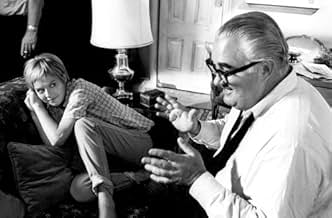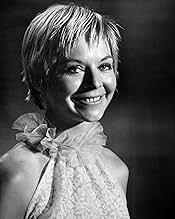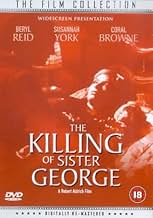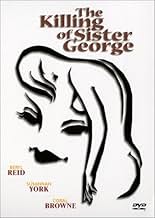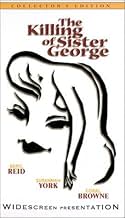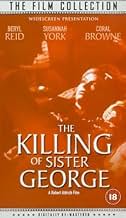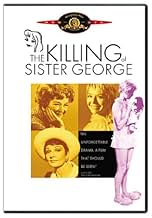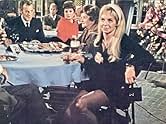IMDb-BEWERTUNG
7,0/10
2711
IHRE BEWERTUNG
Das Leben einer Seifenopernschauspielerin beginnt in dem Moment aus den Fugen zu geraten, als sie befürchtet, dass ihre Rolle aus der Serie gestrichen werden könnte.Das Leben einer Seifenopernschauspielerin beginnt in dem Moment aus den Fugen zu geraten, als sie befürchtet, dass ihre Rolle aus der Serie gestrichen werden könnte.Das Leben einer Seifenopernschauspielerin beginnt in dem Moment aus den Fugen zu geraten, als sie befürchtet, dass ihre Rolle aus der Serie gestrichen werden könnte.
- Regie
- Drehbuch
- Hauptbesetzung
- Auszeichnungen
- 1 Nominierung insgesamt
Empfohlene Bewertungen
Seeing Beryl Reid mouth silently a four-letter swear word when such things didn't happen in films and drunkenly canoodling with two young nuns in the back of a London cab is both quite outstanding and rather lovable.
Miss Reid, who I only got to see in my childhood as a twee, granny-like innocent (the sort that she plays for real in a TV serial as Sister George, a homely district nurse), I found The Killing Of... both delicious and ever astounding in its frankness and of her rather warped relationship with the much younger Susannah York.
Warped, not because of the age difference, nor of their same-sex partnership, but because June Buckridge (Reid) has a cruel streak that is borne out by her playing sadistic mind games with Alice "Childie" (York).
Sister George, in the best tradition of TV soaps, is being killed off, to make way for an Australian replacement. Hence June's venomous outpourings and increasingly erratic behaviour.
Equally interesting is the London of the late '60s, both in its landmarks but also its people and fashions, whether that's in how they live and/or how they dress and present themselves.
Though real soaps cover such material freely and openly these days, 42 years ago, it must have been a very different kettle of fish. Lesbianism back in those days was not only considered immoral but also a mental aberration and had to be so hidden, in an attempt to prove to those 'righteous' souls that it did not exist. Therefore, it must have been a very brave undertaking as a film, though it originated as a play, written by Frank Marcus.
Having now seen it again, I consider Robert Aldrich's ground-breaking film to be a bit of a classic and one, which, no doubt I'll want to see again in a few years time. It really is a piece of British cinematic history.
Miss Reid, who I only got to see in my childhood as a twee, granny-like innocent (the sort that she plays for real in a TV serial as Sister George, a homely district nurse), I found The Killing Of... both delicious and ever astounding in its frankness and of her rather warped relationship with the much younger Susannah York.
Warped, not because of the age difference, nor of their same-sex partnership, but because June Buckridge (Reid) has a cruel streak that is borne out by her playing sadistic mind games with Alice "Childie" (York).
Sister George, in the best tradition of TV soaps, is being killed off, to make way for an Australian replacement. Hence June's venomous outpourings and increasingly erratic behaviour.
Equally interesting is the London of the late '60s, both in its landmarks but also its people and fashions, whether that's in how they live and/or how they dress and present themselves.
Though real soaps cover such material freely and openly these days, 42 years ago, it must have been a very different kettle of fish. Lesbianism back in those days was not only considered immoral but also a mental aberration and had to be so hidden, in an attempt to prove to those 'righteous' souls that it did not exist. Therefore, it must have been a very brave undertaking as a film, though it originated as a play, written by Frank Marcus.
Having now seen it again, I consider Robert Aldrich's ground-breaking film to be a bit of a classic and one, which, no doubt I'll want to see again in a few years time. It really is a piece of British cinematic history.
This movie is a heck of a lot more relevant than more recent films dealing with lesbianism -- the shallow, lame DESERT HEARTS comes to mind. Though over two hours long, TKOSG held me with little effort. The action moved freely from the studio to the apartment to the pub. And the seduction scene was totally erotic and ... well ... never mind. Was this particular scene overly long? Only to a generation raised on sex scenes which rarely last as long as it takes to cook a three-minute egg. Explicit? Grow up!
And the performances ... wow! I had no problem with the hold George had over Childie, with Beryl Reid's superior portrayal complemented perfectly by Susannah York's fragile and, at the same time, forceful Childie. I must admit, York was a bit over the top in the beginning, but I wouldn't say that if I didn't count her as one of my all-time favorite actresses. And how about Coral Browne -- she was sensational! Sublty menacing, eerily sensuous -- and when I realized this was the same woman from AUNTIE MAME and LYLA CLARE, well, I nearly fell off my chair. I love this lady!
And the performances ... wow! I had no problem with the hold George had over Childie, with Beryl Reid's superior portrayal complemented perfectly by Susannah York's fragile and, at the same time, forceful Childie. I must admit, York was a bit over the top in the beginning, but I wouldn't say that if I didn't count her as one of my all-time favorite actresses. And how about Coral Browne -- she was sensational! Sublty menacing, eerily sensuous -- and when I realized this was the same woman from AUNTIE MAME and LYLA CLARE, well, I nearly fell off my chair. I love this lady!
While there is delicate humor here, as in the movie's satire on the twee reassurances and stereotyping of an English soap opera's portrayal of homely English village life, this movie is in the end an unsettling portrait of the human condition, of the ugliness, the uncontrollable and incendiary nature of our sexual and emotional longings and need.
I spent years wanting to see this movie, if only because of its legendary nature and Coral Browne's presence in the cast, and it's nothing like what I imagined. Given the title and all the talk in books about scenes set in a dark and intense demimondaine world of lesbian bars, I pictured some sort of police procedural about lesbians being killed by a serial killer, a Sidney Sheldon-type story.
Ostensibly a portrait of an aging actress's dying career, the heart of the picture is the competition among the characters for love, for the ruthless quest for success and the money and companionship that go with it.
There is constant sado-masochistic emotional gamesmanship here, with characters playing roles that are alternately passive and active. One character pretends to be not much more than a slip of a girl and sits by and watches as others compete for her attentions.
The sex scene in the movie, while ugly in the extreme, is vital to the film's message. (I'm amazed that this aired, even late at night, on Turner Classic Movies, so that I, thankfully, got a chance to see the movie.) Coral Browne's face, stripped of its mask of demure self-possession, exposing the animal (the monster?) that we all are at the core of our being--that's something to see. And unsettling.
I'll never particularly care for Susannah York. She'll always strike me as a bit of an over-praised, over-successful relic of the 1960s, a kind of prissy relic, but what a film, even with some longeurs. And the towering--both literally and figuratively--Coral Browne: what a presence.
I spent years wanting to see this movie, if only because of its legendary nature and Coral Browne's presence in the cast, and it's nothing like what I imagined. Given the title and all the talk in books about scenes set in a dark and intense demimondaine world of lesbian bars, I pictured some sort of police procedural about lesbians being killed by a serial killer, a Sidney Sheldon-type story.
Ostensibly a portrait of an aging actress's dying career, the heart of the picture is the competition among the characters for love, for the ruthless quest for success and the money and companionship that go with it.
There is constant sado-masochistic emotional gamesmanship here, with characters playing roles that are alternately passive and active. One character pretends to be not much more than a slip of a girl and sits by and watches as others compete for her attentions.
The sex scene in the movie, while ugly in the extreme, is vital to the film's message. (I'm amazed that this aired, even late at night, on Turner Classic Movies, so that I, thankfully, got a chance to see the movie.) Coral Browne's face, stripped of its mask of demure self-possession, exposing the animal (the monster?) that we all are at the core of our being--that's something to see. And unsettling.
I'll never particularly care for Susannah York. She'll always strike me as a bit of an over-praised, over-successful relic of the 1960s, a kind of prissy relic, but what a film, even with some longeurs. And the towering--both literally and figuratively--Coral Browne: what a presence.
I did not see the stage play upon which this film is based (too young) but, based on its own merits, this film surely deserves a closer look.
The central trio of performers (Reid, York, Browne) provide career "bests" and there are some amusing vignettes from the others (Fraser, in particular, as a truly odious soap actor).
The much-discussed sex scene is, by today's standards (and, it would seem, even those of the 1960s stage play), tame, but its real value as a display of the shift of power between the three central characters is very neatly worked through in the closing quarter.
The final five minutes of (self-) destruction is heartbreaking, with excellent use made of the music track.
In short: miss it and miss out.
The central trio of performers (Reid, York, Browne) provide career "bests" and there are some amusing vignettes from the others (Fraser, in particular, as a truly odious soap actor).
The much-discussed sex scene is, by today's standards (and, it would seem, even those of the 1960s stage play), tame, but its real value as a display of the shift of power between the three central characters is very neatly worked through in the closing quarter.
The final five minutes of (self-) destruction is heartbreaking, with excellent use made of the music track.
In short: miss it and miss out.
Anyone who likes gritty, clever, slightly comical drama should see this one. The plot is simple enough - an alcoholic gay actress worried about her future in a top Coronation Street-style soap opera - but the way the film is put together is pithy without being too complex - the characterisations are brilliantly satirical, showing up the worst side of the soap opera industry and its catty, backstabbing nature. You don't find yourself feeling sorry for anyone at the end of it apart from perhaps Susannah York. Lots of London-in-the-1960s location filming and familiar faces - I'm only surprised that John Le Mesurier doesn't appear in it. In a word - absorbing. Why don't they make them like this anymore?
Wusstest du schon
- WissenswertesThe lesbian lovemaking scene so disgusted Robert Aldrich's longtime composer friend Frank De Vol that he quit the production and didn't work with Aldrich for several years.
- PatzerWhen George asks for a pint of beer the waiter arrives with it on a tray and it is half full with half a glass of head but when he puts it on the table it's much fuller, with only about an inch of head on it.
- Crazy CreditsDuring the opening credits, the picture distractingly flips from left to right as the main character travels through claustrophobia-inducing alleyways.
- VerbindungenFeatured in Before Stonewall (1984)
Top-Auswahl
Melde dich zum Bewerten an und greife auf die Watchlist für personalisierte Empfehlungen zu.
- How long is The Killing of Sister George?Powered by Alexa
Details
- Erscheinungsdatum
- Herkunftsland
- Sprache
- Auch bekannt als
- The Killing of Sister George
- Drehorte
- Produktionsfirmen
- Weitere beteiligte Unternehmen bei IMDbPro anzeigen
- Laufzeit
- 2 Std. 18 Min.(138 min)
- Sound-Mix
- Seitenverhältnis
- 1.85 : 1
Zu dieser Seite beitragen
Bearbeitung vorschlagen oder fehlenden Inhalt hinzufügen


